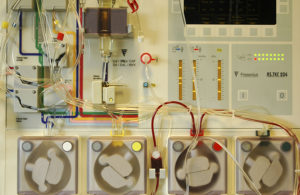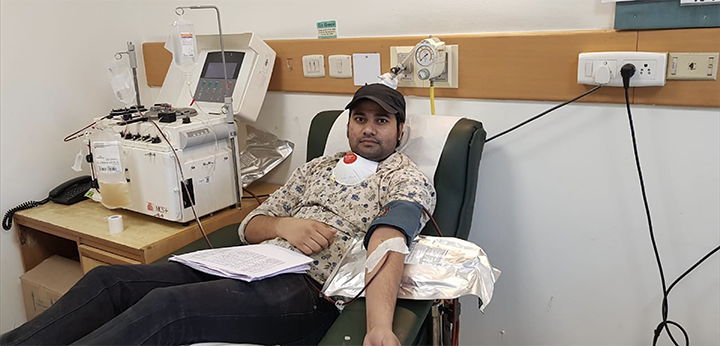Plasma therapy trials are showing encouraging results in Delhi’s designated hospitals, though there is difficulty getting donations from cured patients and the treatment is not always successful
In April, over 100 employees of the Dr Baba Saheb Ambedkar Hospital in Delhi tested Covid-19 positive. One of them is Jitendra Verma, a member of the nursing staff of the Medical emergency who recovered, and on June 1 became one of the few donors for plasma therapy.
“I got a call saying that an elderly patient of Coronavirus was in a serious condition at Max Hospital, Saket. I went and donated my plasma for the therapy. The patient recovered and was discharged on 16 June,” Verma is now back at his job in the Delhi government-run hospital which is now a dedicated Covid-19 facility.
“Before we tested positive, the hospital was administering us hydroxychloroquine tablets (as a preventive). I was in the third week of the therapy, but it didn’t help as when we came in contact with the positive patient, we all got infected. After we were sent on quarantine, I started taking paracetamol and azithromycin, and I was gargling and taking steam inhalation. I think because I was maintaining a healthy routine, my body could fight it out.” Verma’s health didn’t deteriorate, and with his colleagues could leave the quarantine centre which was Hotel Ginger, on 10 May.
The Union Health Ministry has finally approved convalescent plasma therapy for treating coronavirus patients in a moderate stage of criticality. This has been included in its updated 13 June Clinical Management Protocol for Covid-19 patients. It has also included the use of anti-viral drug Remdesivir as part of “investigational therapy” only for restricted emergency use and off-label application of immunomodulator tocilizumab.
As early as April, the Delhi government had started plasma therapy trials, with five successful results at month-end. A person involved in the effort to get patients to donate plasma says only about 80 have till now given the nod. While some phone numbers to contact the recovered patients have proved to be wrong, those who do succeed in getting through are sometimes met with demands for money. One recovered patient demanded as much as Rs 25,000 for plasma, one even went higher, demanding Rs 50,000 — while reasons for rejections are inability to take on more stress or the inconvenience of it.

Mancy Maman, also a nursing staff at Ambedkar hospital and Verma’s colleague, agreed to donate her plasma but coordinating it has been difficult. The quarantine was a hard time for her and her family, as her kids are being looked after by her elderly parents. “I work full time in a Covid-19 hospital and also have two young children, it becomes hard for me to move around. My parents get angry with me saying, ‘You are already doing enough, why do you have to make your family suffer more’?”
Maman did receive a call from Ganga Ram Hospital one time, “I gave my (blood) sample, and was asked to come back. I didn’t get a call again so I don’t know what became of it. I can’t keep going when I have this job and other responsibilities.” And with the chance of contracting the disease being ever present, she cannot be too careful.
Unlike her colleagues, she did not take HCL medication because she is breastfeeding. Before they were diagnosed, she had no symptoms. “We were in contact with a patient with severe kidney disease who had come for dialysis. On 16 April, she was told that she would need to get a Covid-19 test. On 17 April, she was brought back and we were told her condition had deteriorated. So, we shifted her to a normal ward and then she was shifted to dialysis. After that we separated her, started using PPE kits and took her Covid-19 samples, but it was too late by then. In our ward, almost 21 staff members were infected and people are still coming positive. The chain has not been broken in our hospital”, Maman says.
The patient died on the 18th and her test results came on the 20th. The staff was tested the next day and on the 22ndthey were quarantined.
“I had a little headache on the 21st and I remember it was 6 pm, my evening shift. I thought the headache was because of the cap we were wearing so I just took paracetamol. Then the next day I still had a headache plus body ache. So, I took medicine and rested. After two days, I had lost my sense of taste and odour. Thankfully the attack wasn’t too severe for me. On 7 and 8 May we were tested and both results came negative on the 9th, so we returned to our homes the next day. And then on the 18th I joined work.”
She says that people who step out, don’t have any symptoms and even those at an early stage of the virus must continually gargle and steam. “It will keep the lung airways clear and prevent pneumonia to some extent. So, people should use this basic measure every day, as many times as possible.”
For people who get worse symptoms, plasma therapy is looking more and more like a viable option. Twitter and Reddit have posts from people asking for plasma donors for their loved ones.
Blood or plasma from recovered patients has been tried as a therapy since at least the Spanish flu of 1918, Science magazine points out. It has also been used to fight measles, severe acute respiratory syndrome, and lesser-known diseases such as Argentine hemorrhagic fever. In a 1970s study of 188 patients with that disease, only 1% of plasma recipients died, versus 16.5% in a control group died.
A study conducted by Houston Methodist hospital, published in the American Journal of Pathology says that out of the 25 sick patients given plasma transfusions, 19 improved and 11 left the hospital.
Lead researcher of the “Treatment of COVID-19 patients with convalescent plasma”, and chair of the department of pathology and genomic medicine at Houston Methodist hospital Dr. James Musser says, “While physician scientists around the world scrambled to test new drugs and treatments against the COVID-19 virus, convalescent serum therapy emerged as potentially one of the most promising strategies”.
It should be mentioned here, though, that plasma therapy has not always been successful.
The hospitals currently approved to work on plasma therapy trials in Delhi are All India Institute of Medical Sciences (AIIMS), Indraprastha Apollo Hospital, Batra Hospital, Lady Hardinge Medical College, Ram Manohar Lohia (RML) Hospital, Max Hospital Saket, Institute of Liver and Biliary Sciences (ILBS) and Maulana Azad Medical College.
(Cover: Jitendra Verma, a nursing staff at Dr Baba Saheb Ambedkar hospital donates his plasma at Max hospital PHOTO: JITENDRA VERMA)





